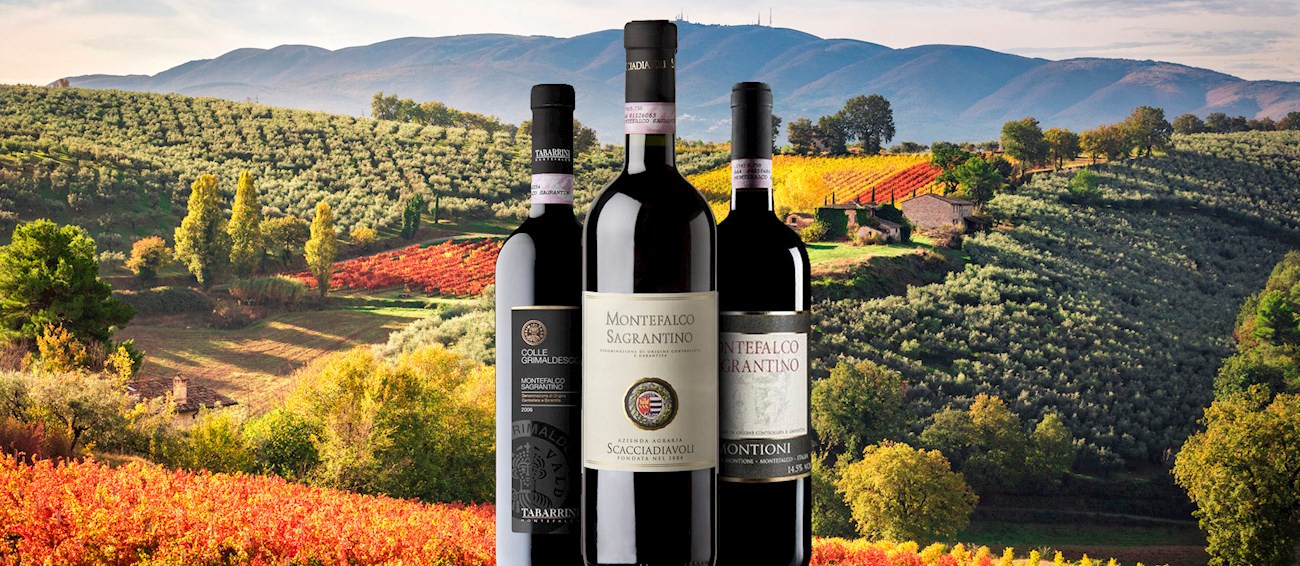TABLE OF CONTENTS
Best Umbrian Red Wine Types
Sagrantino is an Italian grape variety that is thought to be native to Umbria. It is mostly cultivated in a small area around Montefalco in Perugia, which is also the location of its flagship appellation, the DOCG Montefalco Sagrantino.
This thick-skinned grape is known to produce full-bodied and tannic red wines. The grape can be used in varietals and blends—it is mostly blended with Sangiovese in Montefalco Rosso DOC. Sagrantino-based wines are rich in color, tannins, acidity, and sugar.
Usually, they also tend to have high alcohol content. These intense and powerful wines have aromas of red and dark berries, violets, and hints of herbal and balsamic-like notes.
Montefalco Sagrantino is an Italian appellation for dry red wines that are made exclusively from the local Sagrantino grapes. The wines are incredibly tannic, full-bodied, and powerful, with delicate aromas of red and dark fruits, star anise, as well as hints of violets, tobacco, vanilla, licorice, and leather.
Because of high tannins, Montefalco Sagrantino ages exceptionally well, and though the minimum aging period is 37 months, out which one year must take place in oak, most varieties will benefit from longer aging. It is also recommended to decant the wine before serving.
Torgiano Rosso Riserva is an Italian DOCG appellation located around Torgiano, Perugia. The region produces complex and elegant red wines based on Sangiovese, which has to make a minimum of 70 %. Other permitted varieties include Cabernet Sauvignon, Merlot, Canaiolo, and Colorino.
The wines are floral and fruity, with aromas that are reminiscent of violets, roses, cherries, and plums. These wines can age exceptionally well. As they age, they tend to develop jammy, toasty, and leather notes with hints of spice. On the palate, they are incredibly well structured, powerful, and round, with good acidity, freshness, and fine tannins.
Montefalco Rosso is an Italian appellation located in Umbria that produces fruity red wines with at least 60% Sangiovese and a minimum of 10% Sagrantino grapes. The rest of the blend can be made with other red grapes cultivated in the region.
Montefalco Rosso will usually have a fruity and subtly spicy character, pleasant acidity, and well-structured tannins. These wines are not over-powering and may be enjoyed with various courses, but they work especially well with white meat, pasta dishes, charcuterie, soups, and vegetables.
TasteAtlas food rankings are based on the ratings of the TasteAtlas audience, with a series of mechanisms that recognize real users and that ignore bot, nationalist or local patriotic ratings, and give additional value to the ratings of users that the system recognizes as knowledgeable. TasteAtlas Rankings should not be seen as the final global conclusion about food. Their purpose is to promote excellent local foods, instill pride in traditional dishes, and arouse curiosity about dishes you haven’t tried.




